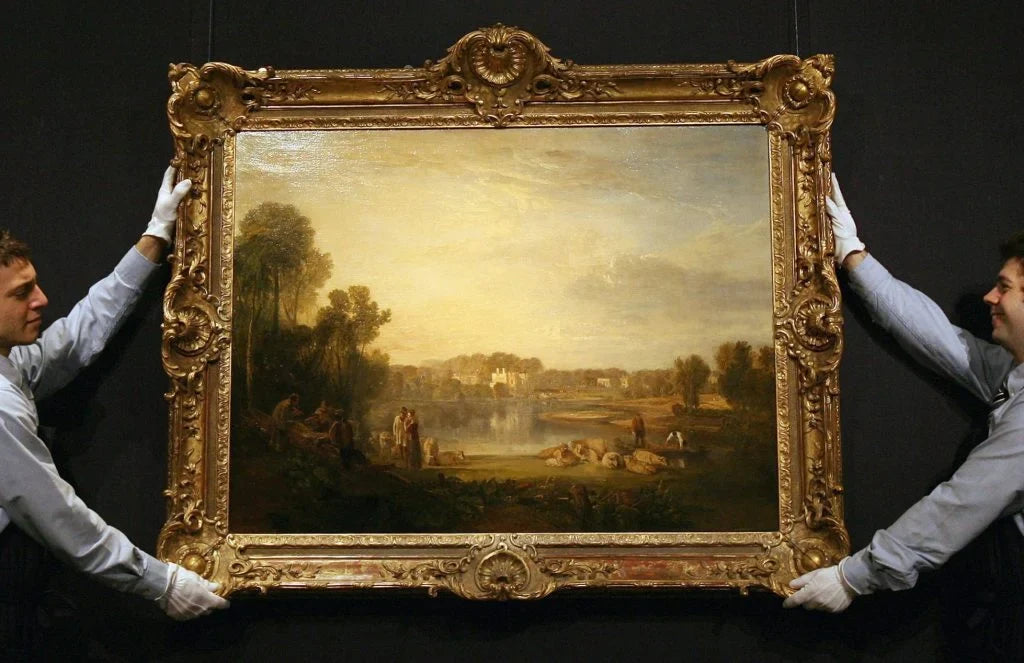
J.M.W. Turner at 250 - A Journey Through His Greatest Masterpieces
Share
As the art world celebrates the 250th anniversary of Joseph Mallord William Turner in 2025, renewed attention focuses on the vast and influential oeuvre of this pioneering British artist. Known as the “painter of light,” Turner’s revolutionary approach to landscape and seascape painting forever changed how artists depict nature’s atmosphere and emotion. His work bridges the realms of Romanticism and modern art, inspiring generations of painters to explore light, color, and mood in new ways.
Turner’s early landscapes, rooted in precise realism and topographical detail, can be explored in exhibitions at the Tate Britain, which houses the world’s largest collection of his paintings. Over time, Turner’s style evolved towards expressive brushwork and atmospheric effects that laid the groundwork for Impressionism and abstraction.

Iconic Masterpieces Defining Turner’s Legacy
Among Turner’s most celebrated works, The Burning of the Houses of Lords and Commons, 16 October 1834 dramatically captures a historic fire engulfing London’s Parliament. The painting’s vivid interplay of light and shadow symbolizes a political and cultural transformation, a subject still discussed by scholars and curators at major institutions like the National Gallery, London.
Another signature work, The Fighting Temeraire (1839), poignantly depicts the majestic warship’s last voyage before dismantling. Here, Turner contrasts the glowing sunset with the fading age of sail, highlighting themes of change and industrial progress. This masterpiece remains a highlighted piece in the National Gallery’s collection.

Turner’s fascination with natural forces is powerfully conveyed in Vesuvius in Eruption (1817–1820), held by the Yale Center for British Art. Though Turner never witnessed the eruption firsthand, the painting conveys the sublime terror and beauty of nature with awe-inspiring energy and vivid color contrasts.
Additionally, Venice, The Bridge of Sighs (1840) demonstrates Turner’s mastery of light and atmosphere. The ambient glow and poetic composition invite viewers into a meditative reflection on place and memory. His layered view of Modern Rome, Campo Vaccino (1839), at the J. Paul Getty Museum, further exemplifies Turner’s ability to blend ancient history with the present moment through shimmering, luminous effects.

Celebrating Turner’s Enduring Influence
Turner’s innovation extends beyond his paintings; he also revolutionized watercolors and printmaking, pushing media boundaries throughout his career. His legacy is celebrated annually through exhibitions and awards like the Turner Prize, named in his honor. Institutions such as the Peabody Essex Museum have hosted major thematic exhibitions, exploring Turner’s lifelong nautical themes and techniques.
As recorded on the dedicated Tate artist profile page for J.M.W. Turner, Turner’s lifetime output included over 550 oil paintings and thousands of works on paper. Collectors and museums worldwide continue to prize his oeuvre, noting its profound impact on 19th- and 20th-century art developments.

Images and Sources
-
The Burning of the Houses of Lords and Commons — Tate Britain
-
The Fighting Temeraire — National Gallery, London
-
Vesuvius in Eruption — Yale Center for British Art
-
Venice, The Bridge of Sighs — Tate Britain
-
Modern Rome, Campo Vaccino — J. Paul Getty Museum
-
Exhibition: Turner & the Sea — Peabody Essex Museum
Key Anchor Keywords and Links
FAQ
Q1: Who was J.M.W. Turner and why is he important?
A1: Turner was a British Romantic painter renowned for his groundbreaking exploration of light, color, and atmosphere. His work ushered landscape painting toward modern artistic movements like Impressionism and abstraction.
Q2: What are some of Turner’s most famous paintings?
A2: Iconic works include The Burning of the Houses of Lords and Commons, The Fighting Temeraire, Vesuvius in Eruption, Venice, The Bridge of Sighs, and Modern Rome, Campo Vaccino.
Q3: Where can I see Turner’s works in person?
A3: Major collections are at Tate Britain, the National Gallery in London, Yale Center for British Art, and the J. Paul Getty Museum.
Q4: How did Turner influence later art movements?
A4: Turner's expressive use of color and light anticipated Impressionism and abstract art, influencing countless artists searching for new ways to represent nature and emotion.
Q5: What themes are central in Turner’s paintings?
A5: Core themes include the sublime power of nature, historic events, technological change, and the emotional interplay of light and atmosphere.
Q6: How is Turner’s legacy honored today?
A6: His legacy is maintained through museum exhibitions, public displays, and the Turner Prize, which celebrates innovation in contemporary art.
J.M.W. Turner’s art remains a timeless beacon of innovation and emotional depth, offering a compelling bridge between past artistic traditions and the future of visual expression.
